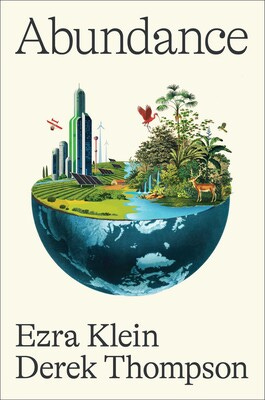Biotech Czar for a Day: An Abundance Agenda for Biotech
A thought experiment on how we can make our Biotech ecosystem more abundant
I took some time off over spring break to rest, recharge, and catch up on ideas that spark real change. While I’m not usually buried in books, many of you know I’m a massive podcast fan—and I’m a long‑time listener to Ezra Klein (The Ezra Klein Show) and Derek Thompson (Plain English). So, when I heard they were co‑authoring a book called Abundance, I couldn’t resist diving in. Abundance argues that by shifting from a scarcity mindset and reforming outdated regulations and ideologies, society can unleash a transformative era of growth, innovation, and widespread prosperity. Over spring break, I read the book and found this vision—shifting from a scarcity mindset to one focused on building more—truly compelling. Despite the authors targeting the book at the Democratic Party, the book’s core ideas are worth a read regardless of where you fall on the political spectrum. I even had the pleasure of attending a live discussion with both authors and Michael Pollan, which further deepened my appreciation.
This got me thinking: If I were Biotech Czar for a day—with full government muscle at my disposal—what would an “Abundance Agenda” for biopharma look like? Today, I’m exploring that thought experiment. In our field, “supply” means more than just a greater number of approved drugs. It means bolstering every link in the chain—from rapid discoveries to faster regulatory reviews, expanded manufacturing capacity, robust clinical trial networks, and a deep talent pipeline. Let’s break down the current bottlenecks and then lay out bold, government‑led strategies to overcome them.
I. The Problem: Where Biotech Is Starved
1. Accelerating Drug Approvals
The challenge isn’t that there aren’t enough drugs getting approved—it’s that the pathway to market is often too slow, with prolonged Phase III studies and lengthy FDA review processes delaying critical therapies. While the FDA is already taking steps with programs like Fast Track, RMAT, and Project Orbis, there is significant potential to further accelerate approvals through increased staffing, AI-driven review tools, and streamlined data requirements, ensuring that life-saving drugs reach patients much faster.
2. Skewed Capital Allocation
Too much capital is chasing the same safe bets—iterative “me‑too” projects such as redundant CD19 CAR‑T therapies, the umpteenth PD‑1×VEGF bispecific, and the one-millionth GLP-1 analog. While these innovations are important for increasing competition and driving incremental improvements, they crowd out funding for high‑risk, transformative ideas that could fundamentally reshape patient care, as well as ideas that have simply gone out of vogue. Our investment landscape can become over-concentrated, especially in down-markets, leading to a homogenized portfolio where the promise of breakthrough therapies is stifled by repetitive projects.
3. Expanding the Frontier of Discovery
New medicines begin with breakthroughs in understanding—discoveries that reveal previously unknown receptors, genetic relationships, or cellular behaviors that unlock entirely new therapeutic strategies. To truly revolutionize healthcare, we must double down on basic research that expands our knowledge of fundamental biology, from the intricacies of neural receptors to the mechanisms by which specific genes influence immune cell persistence. The broader and richer our canvas of discoveries, the more diverse the array of drug targets we can develop, fueling a continuous pipeline of innovative therapies.
4. Infrastructure Constraints
Even if we accelerate approvals, our ability to produce and test new drugs remains limited. Our manufacturing capacity is often maxed out; existing facilities struggle to scale up production of complex biologics. Similarly, clinical trials are predominantly run in a few major academic centers, which limits diversity in patient data and slows down the overall pace of research. Without expanding these critical infrastructures, increased drug approvals would simply create a new bottleneck.
5. Talent Shortages
A shortage of skilled professionals—ranging from fresh STEM graduates to experienced researchers, regulatory experts, and manufacturing specialists—is a persistent challenge. This talent gap slows down innovation at every stage of drug development. We need not only new graduates but also a system to attract mid‑career professionals from other sectors who can bring fresh perspectives and expertise to biopharma.
Interested in becoming a BPS sponsor?
A sponsored post is 100% accessible to all subscriber levels and gets your brand, product, or service in front of my audience of BioPharma Industry decision-makers right at the beginning of my next post.
If you are interested in featuring your company, product, or services in my next post as a Big Pharma Sharma sponsor, please reach out at info@bigpharmasharma.com. Click the button below to learn how you can sponsor the next edition of Big Pharma Sharma.
6. Gaps in Fundamental Health Research
There is a significant lack of large‑scale, unbiased “Blue Sky” studies aimed at answering fundamental questions about human health. For example, randomized clinical studies on fasting protocols, various diets, or exercise regimens could yield high‑quality data that informs public health and drug development—yet these studies are rarely pursued because no private investor can profit from them.
7. Inadequate Biomarkers and Accelerated Endpoints
Hard clinical endpoints—overall survival, major adverse cardiovascular events, etc.—are core to understanding whether new drugs are actually helping patients live longer. While this is important, it also takes an incredible amount of time and money to pursue. We need a robust investment in the validation of early biomarkers and surrogate endpoints that can better predict long‑term outcomes, thereby facilitating the accelerated approval for drugs targeting many of the major killers of our population (heart disease, stroke, Alzheimer’s, etc.), while we wait for longer-term hard outcomes data to read out.
II. The Abundance Agenda: If I Were Biotech Czar for a Day
Imagine a scenario where I, as Biotech Czar, have full control over government policy. My objective would be simple: Increase the supply of life‑saving therapies by removing bottlenecks in our system and creating a more fertile environment for new ideas to flourish. Here’s how I’d do it, splitting the approach between enhancing existing functions and creating new, bold initiatives.




